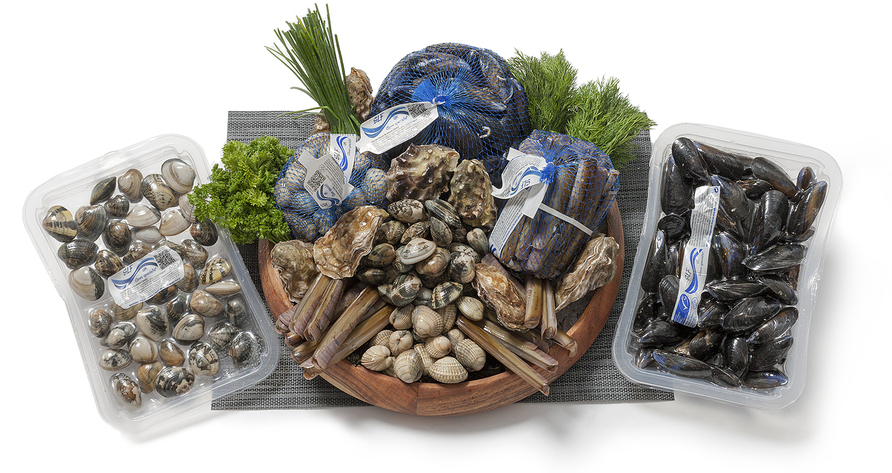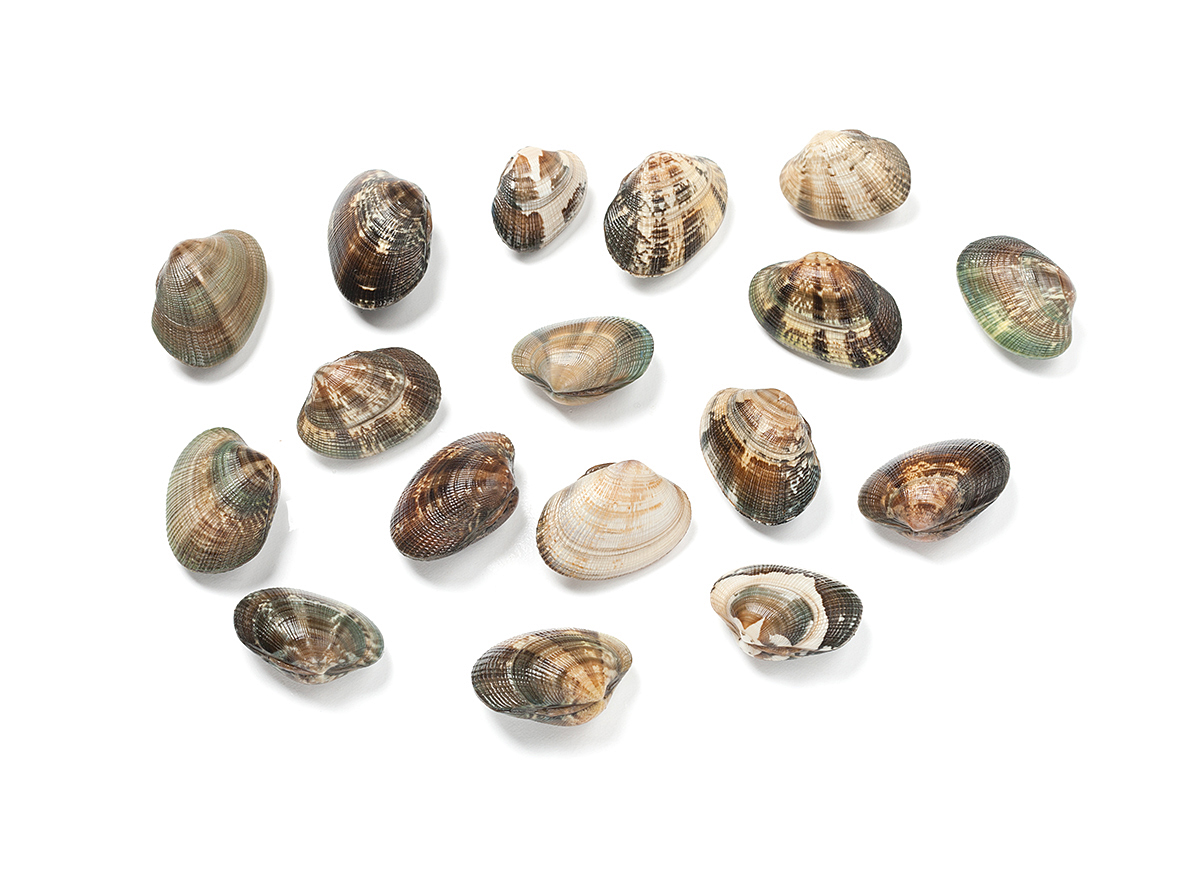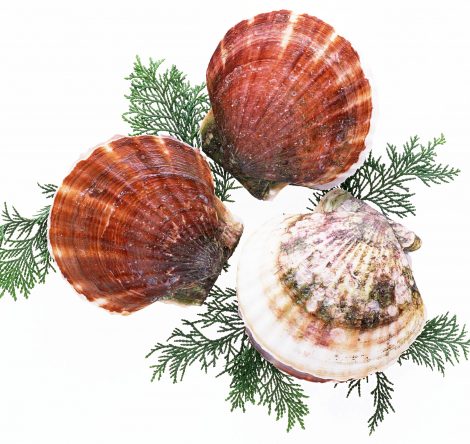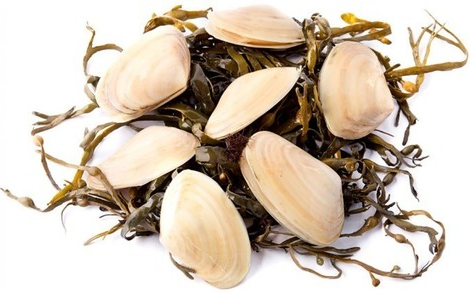

Tapes Semi Decussatus
This product can be found on the coasts of Emilia Romagna and Sardinia, It is quickly spreading outside the breading areas. The shell is rounded, triangular, strong and with crests. It is yellowish grey or brown. The inner surface is smooth with a purple strip. The body tissue is orange. It was imported in the lagoon of Venice in 1983 for commercial use. It can tolerate a range of temperature from 0 to 23 degrees. It can be found is brickish water buried in the sand or in the muddy seabed. It’s reproductive period goes from may to October.
New Zealand GreenShell Mussel


Venus Verrucosa
This shellfish has a globular shell and can be identified by being slightly oblique. It tends to have a grey, yellow and whitish colour with some darker stripes. The diameter ranges from about 4-cm. It resides in slimy waters and is caught with the take during the whole year. It’s predominantly appreciated for it’s pulp sensation.
Ensis
The Ensis species live in clean sand on exposed beaches. They are medium sized and congregate in high numbers around Scotland. They are found to dig very rapidly. The shells are thin, long and parallel-sided. The shame resembles a straight razor (hence the given name) or even a closed jack-knife. Although they have this appearance, the shells in this species are fragile and can be easily damaged when they dig for other clams.


Mytilus Edulis
This mytilus edulis (also known as the blue mussel) is a medium-sized edible mussel from the Mytilldae family. They mostly occupy both coasts of the North Atlantic, Mediterranean and the north pacific. The shape of the shell is triangular with round edges. The shell is very smooth with sculpturing of fine concentric growth lines. It’s colours are purple, blue or sometimes brown. Occasionally, they have radial stripes. This type of mussel is semi-sessile, having the ability to detach and reattach to the surface allowing the mollusc to re-position itself.
Mytilus Galloprovincialis
The mytilus galloprovincialis (also known as the mediterranean mussel) is closely related to the mytilus edulis. In Europe, Mytilus galloprovincialis is found in the Mediterranean Sea and the Black Sea, and on the Atlantic coasts, in Portugal, north to France and the British Isles and Norway. Recently this species has also been found in the European Arctic including northern Norway and Svalbard. In the northern Pacific the species is found along the coast of California, where it was introduced from Europe by human activity in the early 20th century, and also in the Puget Sound region of Washington State. This animal grows up to 140 mm in length. It is a smooth-shelled mussel with a slightly broader base than that of the black mussel.


Crassostrea Gigas
The Crassostrea Gigas was initially introduce in Cornwall, Essex & Wales. It is mostly farmed throughout England, Scotland & Wales but has also established populations in various other global regions. This can be seen in Europe, Norway, Spain, Portugal and Atlantic Coast. The shell can grow up to 18cm long. It can appear with a white to yellowish colour with blueish grey. The shell often has deep purple sections/patches. It can be found on the lower shore and shallow suborbital areas.
Scallop
Scallops are a cosmopolitan family of bivalves which are found in all of the world’s oceans, although never in freshwater. Although they are all over the world, the largest number of species are found living in the Indo-Pacific region. Most species live in relatively shallow waters from the low tide line to 100 meters, while others prefer much deeper water. Although some species only live in very narrow environments, most are opportunistic and can live under a wide variety of conditions. Scallops can be found living within, upon, or under either rocks, coral, rubble, sea grass, kelp, sand, or mud. Most scallops begin their lives as byssally attached juveniles, an ability that some retain throughout their lives while others grow into free living adults.


Paphies donacina
Latine Name: Paphies donacina
Common name: New Zealand Telline
Harvested from the low tide zone, 2 to 4 metres, the Tua Tua has a smooth clean shell and 33% meat to shell ratio. The smooth low profile shell is cream to light moss in colour. It has a distinctive mild, sweet ‘ocean spray’ flavour and a rich, creamy texture. Well suited to both raw and cooked preparations, the Tua Tua is especially suited to dishes consisting of a full flavour. Highly regarded by the local Maori people as a culinary delight, it is superb eating.
TASTE PROFILE
The Tua Tua exhibits a delicate, sweet aroma of fresh kelp and toasted nori. The flavour of the raw clam is lightly oceanic with clean citrus notes. Cooked, the clam has a range of savoury characteristics, reminiscent of lightly smoked fish and Japanese soy.
GRADES
LARGE Approx 14-16 pieces per kg
MEDIUM Approx 20-24 pieces per kg
SMALL Approx 45-50 pieces per kg

